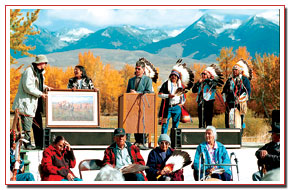 |
By
Doug Coltrin
For years RoseAnne Abrahamson has worked on building an interpretive center to tell the story of Sacajawea, the native Shoshone woman who served as a guide for the Lewis and Clark expedition from 1803-1805.
Last October in Salmon, Idaho, ground was broken for the Sacajawea Interpretive Center. Abrahamson says that this is one of the major events for the commemoration of the 200th anniversary of the Lewis and Clark expedition.
The center, which is expected to be completed in 2002, will be designed to tell the story of Sacajawea from her perspective and the perspective of the Lemhi tribe. Sacajawea guided the adventurers from Great Falls to the Lemhi Valley in Idaho serving as a navigator, diplomat, and translator who accompanied the expedition for a year and a half.
Abrahamson said, "It is going to tell her history and the history of her people." "The center is going to have three phases. It will basically be a geographical interpretive." According to Abrahamson there will be some things that will make this center unique. "Weíre going to recreate a Lemhi village. They are going to have a trail and walkways."
All of the tribes whose land was crossed by the original expedition were invited to Salmon for the groundbreaking. She said that it took a lot of work to research each tribe, contact them and get the word out. "Some of the direct descendants will be there." Among those descendants are a descendant of William Clark, and also one of Patrick Gass.
Abrahamson says that the proximity of the interpretive center to the location of the trail in the Lemhi Valley is also important. She said that it was the only spot, according to surveys and journals, on the Lewis and Clark Trail where they could actually be on the ground where Lewis and Clark first entered the area.
 |
| Leading
the way |
Abrahamson said many things led to the building of the center. One of these things was the U.S. Mint deciding to put Sacajawea on the new one-dollar coin. According to Sen. Mike Crapoís Web site the reason for choosing Sacajawea was simple. "The decision was based on public comments. After considering seventeen design concept presentations, as well as numerous other public suggestions via mail, phone, and e-mail messages, the Dollar Coin Design Advisory Committee (DCDAC) recommended that the coin bear the image of Sacajawea."
Abrahamson said that this was also a big event for her and her family. "My sister was one of the people who lobbied for Sacajawea to be on the coin." Abrahamson said that this and other things got the ball rolling for the new center. "All these factors and dynamics brought this project about."
|
 |
 |
| Rose
Anne Abrahamson (second from left) during the Interpretative
Center groundbreaking last fall. (Sho-Ban news, photo Rod K.
Ariwite Jr.) |
Abrahamson was one of those who worked on the project of building the center. In order to do the research and raise the funds for this building they started by going to the local communities. Once they did that they went to the national level. Throughout the whole process Abrahamson said she experienced many moments of joy and many moments of frustration. She also said that she is very excited to be at this point. "Weíre absolutely thrilled to be at this magical moment. Itís going to be a wonderful moment."
Land was recently secured for the building. According to the Salmon
Recorder-Herald and the Sho-Ban News, the deeds were signed, and
money for the project was secured last September. The Recorder-Herald
said many local and state dignitaries were there to celebrate the
occasion, including Idaho Senator Larry Craig and Salmon Mayor Stan
Davis. According to the article, both elaborated on how beneficial
it would be to the area and how the recognition for Sacajawea and
her birthplace, was greatly deserved. Craig called the center, "An
asset to the community representing a great piece of heritage."
Davis added, "The Sacajawea Center will be a lasting commemoration
to Sacajawea and the opportunity to bring unity to separate cultures."
The Lemhi Valley, located in Lemhi County in Eastern Idaho, is also
a significant place for Abrahamson. "My sister and I were raised
in the Lemhi Valley." It is also the homeland for the Lemhi
tribe. The Lemhis are the northernmost band of the Shoshone nation.
The tribe continued to live on their native land until the 20th
century. The name that the Lemhi call themselves is "Ah-guy
Dika" meaning salmon eaters.
Abrahamson said that she has fond memories of living on the native
land in Lemhi County. "We ate wild game. It was a good existence,"
she said.
At the time she did not realize how much her parents gave up to
raise her and her sister there but now she is thankful. "They
sacrificed a lot to be there."
One thing for which Abrahamson has always been grateful is her ancestral
history and the history of her people. She recalled the excitement
that she felt when her father first told her of her ancestry. "I
remember when my father first told us where I came from. I was excited.
It was exciting and interesting."
Abrahamson is descended through Sacajawea’s brother and also
through Chief Tendoy. "Sacajawea is my great-great-great aunt,"
she said. Abrahamson also said that there are no direct descendants
of Sacajawea. "Her son did not have any children."
Abrahamson said that this knowledge has had a great effect on her
life. "The knowledge of my ancestry inspired me to be a historian."
She has obtained her master’s degree in history from the University
of Chicago.
She is currently teaching history at Sho-Ban High School on the
Fort Hall Indian reservation in southeast Idaho. |
 |


